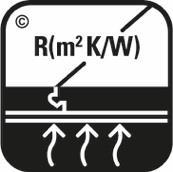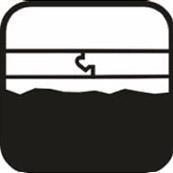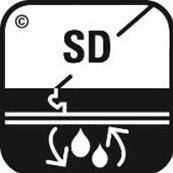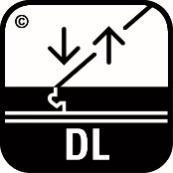Technical requirements for parquet underlays (extract from the technical data sheet of the FEP, European Federation of the Parquet industry Bruxelles, Belgium) www.parquet.net
New standards for quality assessment
After years of preparation in numerous working groups at European level (CEN), but also within the FEP associations, official regulations have been in place since 2018 that define specifications, requirements and test methods for loose laying under floating wood flooring. Before the introduction of such regulations, installation underlays were not described or standardised. Although there are legal requirements in some countries (e.g. the Ü mark), these only regulate fire behaviour and emissions and therefore no performance parameters.
A floating floor can only prove its qualities if the underlayment as a part of the entire flooring system functions optimally. The underlayment represents the connection between the laminate floor and the substrate, and should basically function in the following ways:
Protect the floor permanently
The requirements for suitable underlays are aimed at protecting the floor from daily wear and tear such as falling objects and walking, as well as shielding the floor from rising residual building moisture or damp.
Improve the properties of the floor
In addition to the reduction of impact sound and walking noise, the underlay also influences heat insulation
and walking comfort.
EN 16354
The European standard EN 16354 has been in place since October 2018. This official document from the European Commission addresses all relevant criteria of an underlayment for laminate flooring, defines the test method to be used and specifies basic minimum requirements. This ensures that the specified product properties are comparable and that the underlayment fulfils the minimum requirements stipulated by the CEN.
Technical data sheet of the FEP
The FEP technical data sheet is based on EN 16354 and contains explanations and specific recommendations on technical data for all essential requirements that an underlay must fulfil. Minimum requirements are already defined here, which an underlay should fulfil depending on the type of floor covering. The data sheet also specifies recommendations for increased requirements for underlays.

Underfloor heating/cooling (Rλ,B)
In general, laminate flooring is suitable for use on hot water underfloor heating/cooling systems. In order for the underfloor heating/cooling to work efficiently, the underlay should have the lowest possible thermal insulation, i.e. the total sum of underlay and laminate flooring (Rλ,B) should be as low as possible. Maximum permissible R value of the entire floor:
Underfloor heating: R ≤ 0,15 m²K/W
Underfloor cooling: R ≤ 0,10 m²K/value
Thermal insulation (Rλ)
Laminate flooring has relatively low thermal insulation. On unheated subfloors, an underlay with a high thermal resistance (Rλ) can significantly increase the thermal insulation properties of the flooring system. This increases the surface temperature.
Minimum requirement (underlay only): Rλ ≥ 0,075 m²K/W

To protect the floor mechanically and for acoustic reasons, smaller uneven areas should be avoided. The underlayment should be able to compensate for minor occasional irregularities such as screed granules on the ground. The higher the PC value, the better this compensation
functions.
Minimum requirement: PC ≥ 0,5 mm

Wherever there is mineral substrate, protection against rising dampness or moisture is mandatory to prevent damage to the floor. This can be achieved with an additional water vapour control layer or with an appropriately equipped laminate underlay. The higher the SD value, the better the
protection against rising dampness.
Minimum requirement: SD ≥ 75 m

A typical load on a flooring system is the dynamic load that occurs, for example, when people walk on it (corridor, office, shop, etc.) or when chairs are used (castor chair in offices, chairs in the dining room, etc.). Here, the underlay must be able to withstand repeated short-term loads without changing its properties in the long term. The risk of the floor developing noise (squeaking) can also be reduced by a higher DL value. This ability is expressed by the DL25 value. This involves applying a defined dynamic load (as would normally occur when walking on or driving over with an office castor chair) to the underlay and determining the number of cycles until the underlay changes its properties.
Minimum requirement 10’000 cycles
Increased requirement: 100’000 cycles

Another typical type of load is the permanent static load caused by the wooden floor itself or by fixed,
heavy furniture (cupboard, piano, aquarium table, etc.). Here, the underlay should be able to withstand
the very high static loads without changing its properties.
Static load (CS)
Protection of the connection system
To maximise the service life of the click connections of the planks, the underlay must not yield or deform too much under load. Severe deformation can cause irreparable damage to the click system or the backing board. The ability to support the connection system is indicated by the CS value. Based on practical experience, this should be at least 10 kPa at 0.5 mm compression.
Minimum requirement: 10 kPa bei 0.5 mm
Increased requirement: 60 kPa
Permanent static load (CC)
Permanent compressive stress due to static loads, e.g. furniture
The behaviour of the underlay under long-term loads, for example under heavy furniture, is expressed by the CC value. It is used to assess the behaviour of the underlay under a load duration of 10 years. A value of at least 2 kPa at 0.5 mm compression is recommended here.
Minimum requirement: 2 kPa with 0.5 mm compression
Increased requirement: 20 kPa